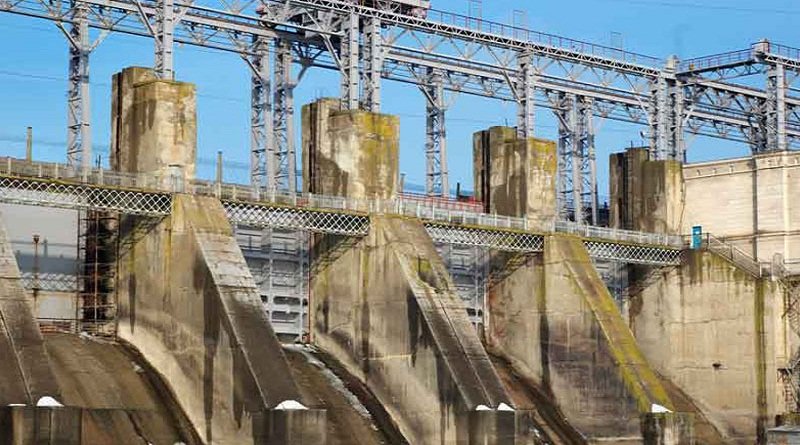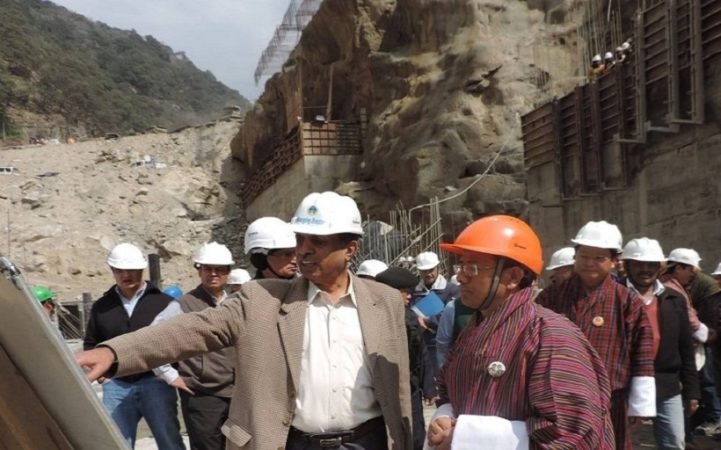Hydro-Power Diplomacy: Connecting India & Bhutan

Hydropower projects in Bhutan are an example of win-win cooperation, providing a reliable source of inexpensive and clean electricity to India, generating export revenue for Bhutan and cementing our economic integration – S.K Sinha*
Diplomatic relations between India and Bhutan were established in 1968 with the
appointment of a resident representative of India in Thimphu. Before this, our relations with Bhutan were looked after by our Political Officer in Sikkim. The basic framework of India- Bhutan bilateral relations was the Treaty of Friendship and Cooperation signed in 1949 between the two countries, which was revised in February 2007.The India-Bhutan Friendship Treaty not only reflects the contemporary nature of our relationship but also lays the foundation for their future development in the 21st century.

Indian Prime Minister Narendra Modi (R) shakes hands with Bhutan Prime Minister Tshering Tobgay/ Image: RAVEENDRAN/AFP/Getty Images)
There are a number of institutional mechanisms between India and Bhutan in areas such as security, border management, trade, transit, economic, hydro-power, development cooperation, water resources. There have been regular exchanges at the Ministerial and officials level, exchanges of parliamentarian delegations to strengthen partnership in diverse areas of cooperation.
Hydropower Diplomacy
hydropower projects in Bhutan are an example of win-win cooperation, providing a reliable source of inexpensive and clean electricity to India, generating export revenue for Bhutan and cementing our economic integration. So far, Government of India has constructed three Hydroelectric Projects (HEPs) in Bhutan totalling 1416 MW (336 M Chukha HEP, 60 MW Kurichhu HEP and 1020 MW Tala HEP), which are operational and exporting surplus power to India About three-fourths of the power generated is exported and rest is used for domestic consumption. Hydropower exports provide more than 40% of Bhutan’s domestic revenues and constitute 25% of its GDP.
The ongoing cooperation between India and Bhutan in the Hydropower sector is
covered under the 2006 Agreement on Cooperation in Hydropower and the Protocol to the 2006 agreement signed in March 2009. Under this Protocol, Government of India has agreed to assist Royal Government of Bhutan in developing a minimum of 10,000 MW of hydropower and import the surplus electricity from this to India by the year 2020.

Hydropower projects in Bhutan are an example of win-win cooperation, providing a reliable source of inexpensive and clean electricity to India, generating export revenue for Bhutan and cementing our economic integration | Image: Flickr
Currently, there are three Inter-Governmental (IG) models HEPs viz. 1200 MW Punatsangchhu-I, 1020 MW Punatsangchhu-II and 720 MW Mangdechhu under construction.
In April 2014, an Inter-Governmental Agreement was signed between India and Bhutan for development of four more HEP’s of capacity 2120 MW (600 MW Kholongchhu, 180 MW Bunakha, 570 MW Wangchu and 770 MW Chamkarchu) under the Joint Venture Model. These projects will have both the JV partners owning 50:50 shareholdings each in the JV- company. The debt-equity ratio would be 70:30, with equity, shared equally between JV partners. Further, MEA is providing Druk Green Power Corporation’s (Bhutanese) share of equity as the grant.
Projects under implementation through IG model
Punatsangchhu-I HEP is a 1200 MW run-of-the-river project located on the left bank of Punatsangchhu river in Wangdue Phodrang Dzongkhag( District) in Western Bhutan. Its estimated capacity is 5700 million units of electricity in an average year. Construction of Punatsangchhu-I HEP commenced in November 2008. In July 2015, the Union Cabinet approved the Revised Cost Estimate of Rs. 9375.58 crore for the project. Physical progress of the progress is 83% as of June 2017.

Punatsangchhu-II HEP | Image: Fiveprime
Punatsangchhu-II HEP is a 1020 MW run-of-the-river project located on Punatsangchhuriver in WangduePhodrang Dzongkhag in Western Bhutan. Its estimated capacity is 4357 million units of electricity in an average year. Construction of Punatsangchhu-II HEP commenced in December 2010 at a project cost of Rs. 3,777.8 crore. In July 2016, the Union Cabinet approved the Revised Cost Estimate of Rs. 7,290.62 crore for the project.Physical progress of the project as of August 2017 is 72%.

Indian and Bhutanese engineers at Mangdechhu Hydro-Electric Project (720 MW), Bhutan | Image: Arvind Kumar Mishra – Linkedin
Mangdechhu HEP is a 720 MW, run-of-the-river scheme located on river Mangdechhu in Trongsa Dzongkhag (District) in Central Bhutan. Annual energy generation from the Project with 95% machine availability would be 2925.25 million units. The bilateral agreement to execute the Mangdechhu Hydroelectric Project was signed between Government of India and Royal Government of Bhutan on 30th April 2010. In March 2016, the Union Cabinet approved the Revised Cost Estimate (RCE) of the project of Rs. 4020.6303 crore (at March 2014 Price Level). Physical progress of the project as of March 2017 is 90%.
Projects under implementation through JV model
Kholongchhu HEP is 600 MW run-of-the-river in the lower course of Kholongchhuriver in Trashiyangtse district of Bhutan. It is the first HEP in Bhutan to be implemented under the Joint Venture model, by a JV-company between Druk Green Power Corporation DGPC) of Bhutan and SJVN Ltd. of India. The foundation stone for the first HEP 600 MW Kholongchhu was laid by Prime Minister Shri. Narendra Modi during his visit to Bhutan in June 2014 and the pre-construction activities are in progress.
Water Resources
There is a Joint Group of Experts (JGE) on flood management between India and Bhutan to discuss/ assess the probable causes and effects of the recurring floods and erosion in the southern foothills of Bhutan and adjoining plains in India and to recommend appropriate measures to both Governments. The last meeting of JGE was held in April 2017 in Thimphu, Bhutan.
There are about 60,000 Indian nationals living in Bhutan, employed mostly in the hydroelectric power and construction industry.
*S. K Sinha is an Independent Columnist on water conservation and water management. He retired as an engineer after serving for 30 years in Ministry of Water Resources, Government of India.


















